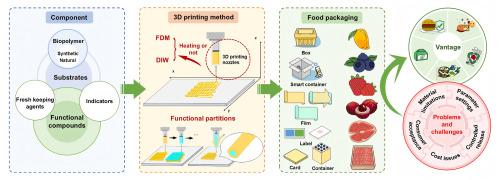3D打印技术在食品保鲜智能包装中的应用
IF 15.4
1区 农林科学
Q1 FOOD SCIENCE & TECHNOLOGY
引用次数: 0
摘要
智能包装利用实时监控和主动保存,为延长食品保质期提供了巨大的潜力。3D打印技术利用其在设计灵活性和材料兼容性方面的优势,为制造下一代智能包装系统提供了一种变革性的方法。一个关键的新颖之处在于它能够实现多功能集成和高度定制的结构,这是传统方法的挑战,与日益强调的可持续性和智能食品科学相一致。范围和方法这篇综述批判性地研究了3D打印和智能包装在食品保鲜方面的整合。它侧重于核心方面,包括创新材料开发,功能包装的先进设计原则,以及保存和传感能力的融合。分析了抗菌包装、实时新鲜度指标和定制保护结构等应用,以及当前面临的挑战和潜在的策略。与传统方法相比,3d打印智能包装具有优异的气体和水分屏障性能,通过嵌入生物活性化合物进行有效保存,并且提高了材料效率。它支持多种基于生物材料的功能性包装系统,包括抗菌包装、实时质量监测传感器和控制内部气氛的定制结构。其在定制设计中结合多种功能的创新能力解决了传统包装的局限性。尽管在标准化、材料工艺优化和可扩展性方面存在持续的挑战,但3D打印在推进可持续食品系统方面显示出巨大的潜力。通过有针对性的研究和安全协议解决这些问题将促进其作为下一代食品保存的领先平台的采用。本文章由计算机程序翻译,如有差异,请以英文原文为准。

3D printing technology applied in smart packaging for food preservation
Background
Smart packaging, utilizing real-time monitoring and active preservation, offers significant potential to extend food shelf life. 3D printing technology provides a transformative approach for manufacturing next-generation smart packaging systems, leveraging its strengths in design flexibility and material compatibility. A key novelty is its ability to enable multifunctional integration and highly customized structures, which are challenging with conventional methods, aligning with the growing emphasis on sustainability and intelligent food science.
Scope and approach
This review critically examines the integration of 3D printing and smart packaging for food preservation. It focuses on core aspects including innovative material development, advanced design principles for functional packaging, and the convergence of preservation and sensing capabilities. The analysis addresses applications such as antimicrobial packaging, real-time freshness indicators, and customized protective structures, along with current challenges and potential strategies.
Key findings and conclusions
3D-printed smart packaging exhibits superior barrier properties against gases and moisture, active preservation through embedded bioactive compounds, and improved material efficiency compared to conventional approaches. It supports diverse, bio-material-based functional packaging systems including antimicrobial packaging, real-time quality monitoring sensors, and tailored structures that control internal atmospheres. Its innovative capacity to combine multiple functions within customized designs addresses limitations of traditional packaging. Despite persistent challenges in standardization, material-process optimization, and scalability, 3D printing demonstrates substantial potential for advancing sustainable food systems. Addressing these issues through targeted research and safety protocols will promote its adoption as a leading platform for next-generation food preservation.
求助全文
通过发布文献求助,成功后即可免费获取论文全文。
去求助
来源期刊

Trends in Food Science & Technology
工程技术-食品科技
CiteScore
32.50
自引率
2.60%
发文量
322
审稿时长
37 days
期刊介绍:
Trends in Food Science & Technology is a prestigious international journal that specializes in peer-reviewed articles covering the latest advancements in technology, food science, and human nutrition. It serves as a bridge between specialized primary journals and general trade magazines, providing readable and scientifically rigorous reviews and commentaries on current research developments and their potential applications in the food industry.
Unlike traditional journals, Trends in Food Science & Technology does not publish original research papers. Instead, it focuses on critical and comprehensive reviews to offer valuable insights for professionals in the field. By bringing together cutting-edge research and industry applications, this journal plays a vital role in disseminating knowledge and facilitating advancements in the food science and technology sector.
 求助内容:
求助内容: 应助结果提醒方式:
应助结果提醒方式:


